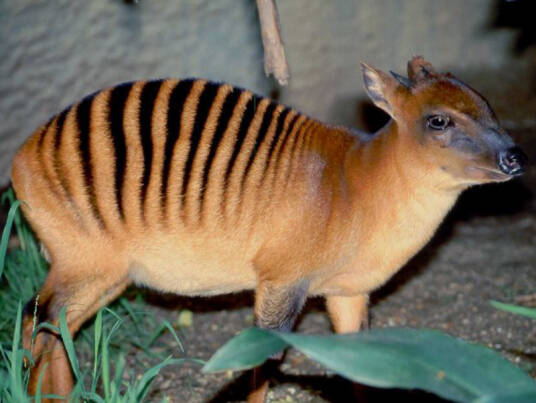Cephalophus zebra
IUCN
LCBasic Information
Scientific classification
- name:Cephalophus zebra
- Scientific Name:Cephalophus zebra
- Outline:Ungulata
- Family:Artiodactylus Bovidae Gazella
Vital signs
- length:85-90cm
- Weight:15-23kg
- lifetime:11-13years
Feature
Possessing one of the most unique fur coats of any mammal
Distribution and Habitat
Distributed in Côte d'Ivoire, Guinea, Liberia and Sierra Leone.
The scaly-backed duiker is found only in the closed canopy rainforests of West Africa. They are very sensitive to disturbance in the forest and prefer to live in primary lowland forests, low mountain and hill forests, and sometimes in secondary forests and weeds.
Appearance
The scaly-backed duiker is 85–90 cm long, 40–50 cm tall at the shoulder, and has a 15 cm long tail; adults weigh 15–23 kg. Both sexes have smooth, sharp horns, 4–5 cm long in males and 2–3 cm shorter in females. The species has one of the most distinctive coats of any mammal, ranging from light golden to reddish brown with 12–16 black (sometimes dark brown) horizontal stripes; this series of stripes begins behind the shoulders and extends to the base of the tail. Each stripe is widest at the spine and tapers as it runs vertically down the sides; each stripe ends at approximately the same level on the sides. The arrangement of the stripes is unique to each individual. The underparts, including the abdomen, chest, and throat, are pale (golden to nearly white) and unstriped. The head, nape, shoulders, and lower legs are dark auburn or chestnut. The cheeks are an overall dark chestnut brown; there are no distinct markings, but the muzzle is black and the lower jaw is white. The thighs are
Details
The spotted duiker (scientific name: Cephalophus zebra) is called Zebra Duiker, Banded Duiker, Zebra Antelope in English, Céphalophe Zébré, Céphalophe rayé in French, Duiquero Cebrado in Spanish, and Zebraducker in German. It has no subspecies and is a species endemic to the Upper Guinea Forest.

The scaly-backed duiker is a nocturnal species that usually lives alone and in pairs. It is shy and rarely seen in the wild. The normal social unit appears to be a breeding pair, which reinforces the pair bond by rubbing, licking, and scent marking. The species is thought to be territorial, and (based on the severe scarring of many individuals) appears to fight very fiercely. Although generally quiet, both sexes make hoarse grunting noises during courtship.
The scaly-backed duiker feeds primarily on fruits, seeds, and leaves, and sometimes animal matter.
The scaly-backed duiker breeds year-round, with conception occurring shortly after birth. Gestation lasts 221-229 days, with one calf born per litter. The female hides the calf in dense vegetation for the first 2-3 weeks after birth, visiting and nurturing it an average of 4 times a day. The calf is weaned in about 95 days. Sexual maturity is reached in about two years. Captive life span is 11-13 years.
In 1999, an estimated density of 2.0 per square kilometer in common areas and 0.2 per square kilometer elsewhere gave a total estimate of about 28,000 individuals. Wilson 2001 considered this an overestimate and suspected that there may be more than 15,000 animals (thus about 10,000 mature individuals) in the range, but population trends have been declining since then due to snaring and shooting, poaching for meat and continued destruction of the few remaining primary forests in West Africa. The only exceptions are some places where hunting pressure is low or there is effective protection against logging and poaching. In 1998, the estimated density in unhunted areas of Sierra Leone was 3-10 per square kilometer; in 2013, it was 0.4 per square kilometer in Taï National Park.
Listed in the IUCN Red List of Threatened Species in 2016 ver3.1 - Vulnerable (VU).
Listed in Appendix I, II and III of the Convention on International Trade in Endangered Species of Wild Fauna and Flora (CITES) 2019 edition Appendix II.
Protect wild animals and eliminate game.
Maintaining ecological balance is everyone's responsibility!








